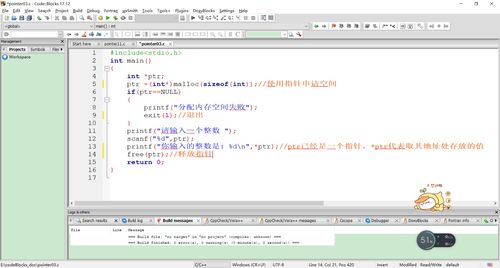malloc源代码(mallocc)
admin 发布:2022-12-19 15:26 136
今天给各位分享malloc源代码的知识,其中也会对mallocc进行解释,如果能碰巧解决你现在面临的问题,别忘了关注本站,现在开始吧!
本文目录一览:
C语言代码求解 源代码如下,求改,求解答
1、目测p1没用,建议去掉;
2、scanf(“%f”,p++);改为scanf(“%f”,p+i);;
3、去掉p=p1;这句;
你改完再试一试。
C语言malloc函数出错
readyqueue-front=(linknode *)malloc(size)一定出错!
因为,此时readyqueue=NULL,它没办法指定-front成员并进行操作.
首先,要给readyqueue赋值或申请空间,前面加上:
readyqueue=(linkqueue*)malloc(sizeof(linkqueue));应该就行了.

急!急!建立一个动态链表,用malloc函数开辟新结点,结点包含姓名、年龄、学号,然后输出的源代码,急求!
#includestdio.h
#includemalloc.h
#includestring.h#define NAMEMAX 50
#define NOMAX 20
#define DATATYPE STUDENT
typedef struct node
{
void *data;
struct node *left;
struct node *right;
}NODE;typedef struct
{
struct node *head;
struct node *current;
struct node *rear;
int count;
}linklist;typedef struct
{
char name[NAMEMAX];
int age;
char no[NAMEMAX];
}DATATYPE;void init_linklist(linklist *list)
{
list-head=NULL;
list-current=NULL;
list-rear=NULL;
list-count=0;
}void add_linklist(linklist *list,void *data)
{
NODE *newNode;
newNode=(NODE *)malloc(sizeof(NODE));
newNode-data=data;
if(list-head==NULL)
{
list-head=newNode;
list-current=newNode;
list-rear=newNode;
newNode-left=NULL;
newNode-right=NULL;
list-count++;
}
else
{
list-rear-right=newNode;
newNode-left=list-rear;
newNode-right=NULL;
list-rear=newNode;
list-current=newNode;
list-count++;
}
}
void free_list(linklist *list,DATATYPE*)
{
NODE *tmp=list-head;
while(tmp!=NULL)
{
if(tmp-left==NULL)
{
tmp=tmp-right;
continue;
}
else if(tmp-right==NULL)
{
free((DATATYPE*)(tmp-data));
free(tmp);
break;
}
else
{
free((DATATYPE*)(tmp-left-data));
free(tmp-left);
tmp=tmp-right;
}
} init_linklist(list);
return;
}void printlist(linklist *list,DATATYPE*)
{
NODE *tmp=list-head;
int i=0;
while(tmp!=NULL)
{
printf("第%d条记录:\n",++i);
printf("----------------------------\n");
printf("姓名为:%s\n",((DATATYPE*)(tmp-data))-name);
printf("年龄为:%d\n",((DATATYPE*)(tmp-data))-age);
printf("学号为:%s\n",((DATATYPE*)(tmp-data))-no);
printf("----------------------------\n");
tmp=tmp-right;
}
return;
}int main()
{
DATATYPE *pStu=NULL;
char buf[50]={0};
linklist list;
init_linklist(list);
while(1)
{
pStu=(DATATYPE*)malloc(sizeof(DATATYPE));
memset(pStu,0,sizeof(DATATYPE)); printf("请输入姓名:");
fgets(pStu-name,NAMEMAX,stdin);
pStu-name[strlen(pStu-name)-1]=0; printf("请输入年龄:");
scanf("%d",(pStu-age));
getchar(); printf("请输入序号:");
fgets(pStu-no,NOMAX,stdin);
pStu-no[strlen(pStu-no)-1]=0; add_linklist(list,pStu);
printf("是否继续添加(y/n):");
memset(buf,0,50);
fgets(buf,50,stdin);
buf[strlen(buf)-1]=0;
if (!strcmp("y",buf) || !strcmp("Y",buf))
continue;
else
break;
}
printf("\n结果为:\n");
printlist(list,0);
free_list(list,0);
return 0;
} //void printlist(linklist *list,DATATYPE*) 楼下的这DATATYPE后面这个类型没意思?? 告诉你这是显示强调里面要使用DATATYPE这个类型,而又不使用它 printlist(list,0); 这句就能体现,还有个功能就是释放内存时你考虑了没 虽然这题free void*指针是可以释放的 但是如果在C++ 中你如果直接释放void*指针 而不指定其类型 那么这个对象就释放不测底 。#define DATATYPE STUDENT 我定义这个宏的目的就是能够方便的智能的释放内存。 如果你把STUDENT的这个结构体改了 不叫这个名字 那么岂不是又要在相关的代码更改名字,而我这个只要修改这个宏就行了,我写这么复杂?告诉你我这个代码基本是直接拷贝的 这代码是以前写过的,使用的通用双向链表 我只是截取了我写的一部分函数写代码的目的是要通用,要能够重复利用。
malloc源代码的介绍就聊到这里吧,感谢你花时间阅读本站内容,更多关于mallocc、malloc源代码的信息别忘了在本站进行查找喔。
版权说明:如非注明,本站文章均为 AH站长 原创,转载请注明出处和附带本文链接;
- 上一篇:qq邮箱源代码(邮箱编程)
- 下一篇:css定位排序代码(定位排序法)
相关推荐
- 05-06dwz网站源代码(dw网站制作的源代码)[20240506更新]
- 05-05精美登录界面源代码模板(登录页面源代码)[20240505更新]
- 05-05小说源码里面的下载代码(小说 源代码)[20240505更新]
- 05-05手机斗地主源代码(斗地主源码下载)[20240505更新]
- 05-05股票分析源代码(股票分析软件源代码)[20240505更新]
- 05-05房产小程序源代码下载(资源下载小程序源码)[20240505更新]
- 05-05unity3d德州扑克源代码的简单介绍[20240505更新]
- 05-05人工智能系统源代码(人工智能代码下载)[20240505更新]
- 05-05易语言源代码下载(易语言下载文件源码)[20240505更新]
- 05-05魔域脚本源代码(魔域互通版脚本)[20240505更新]
取消回复欢迎 你 发表评论:
- 标签列表
- 最近发表
-
- 发布信息的平台有哪些,发布信息都有哪些平台
- 合作伙伴网页代码(合作伙伴网页代码是多少)[20240506更新]
- gif怎么转代码(如何转为gif)[20240506更新]
- java图书馆管理系统代码(图书馆管理系统开源代码java)[20240506更新]
- dwz网站源代码(dw网站制作的源代码)[20240506更新]
- 长沙网站建设的简单介绍
- canny边缘检测matlab代码(基于matlab的边缘检测)[20240506更新]
- qq木马代码(木马软件下载)[20240505更新]
- jquery代码点击复制(jquery复制对象及事件)[20240505更新]
- 租赁车系统代码(汽车租凭系统代码)[20240505更新]
- 友情链接


